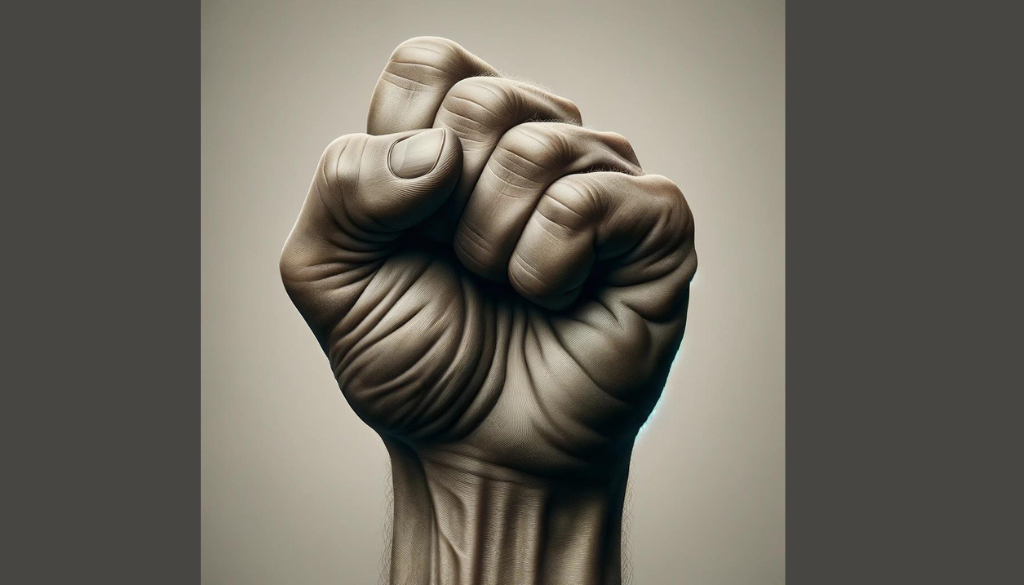Your grip is the handshake between you and your paddle, the silent partner in your volley, and it can make the difference between a winning dink and a shot gone rogue.
There are two aspects to understand when delving into pickleball paddle grips. How you hold your paddle and how tight you hold your paddle.
The three main grips (how you hold your paddle) include the Continental, the Eastern, and the Western—each has its own charms and challenges. The pressure applied (how tight you hold your paddle) is frequently referred to on a 1-10 scale.
The Continental Grip: Your Steady Ally
The Continental, also known as, the ‘Hammer Grip,’ is the bread and butter for newbies. Why? It’s like holding a hammer—you’re ready to nail those shots with precision. For a righty, the knuckle of your index finger rests just right of the top bevel. Southpaws, you’ll go left. Imagine the top of the paddle as a throne, and the V between your thumb and index finger as the Queen, sitting regally atop the handle.
While this is the simplest grip and the most widely used, it is not without a downside. You may not get as much power as you would with other grips, but the trade-off is worth it as it allows for more control and consistency.
The Eastern Grip: The Jack-of-All-Trades
AKA the Handshake Grip: Extend your arm as if greeting an old friend, then wrap your fingers around the paddle’s handle. Your index knuckle will rest on the second bevel. It’s neutral, friendly, and doesn’t pick sides—forehand or backhand, it’s got you covered.
This grip is like your favorite teacher—encouraging and forgiving as you learn. However, when you’re yearning for topspin or a power boost, it may leave you wanting more.
The Western Grip: The Maverick
Now, for the wild child of grips—the Western. It’s the ‘Frying Pan Grip,’ perfect for flipping those pancakes or in our case, imparting wicked topspin. The paddle’s face closes down, a secret handshake for aggressive forehand strikes.
Be wary, though; the backhand can become your Achilles’ heel, awkward like trying to text with your non-dominant hand.
Does Grip Really Matter? Do we all lie about “just one more game?” Absolutely! The grip is your command center. It governs the power, spin, and soul of your shots. Don’t just stick to one—dance between them. When drilling or in lessons, try different grips to see which one you feel most comfortable with. And once you master one, try changing grips for different shots. Thinks of grips like a chef thinks of knives, have a favorite that you use regularly and have others for specific situations.
The Art of Pressure: Finding Your Grip’s Goldilocks Zone
Imagine your paddle is a delicate bird—grip too hard, and you risk crushing its wings; too softly, and it may fly away. We must develop a nuanced balance in order to master grip pressure in different scenarios.
The Perils of Over-Gripping
Gripping your paddle with Herculean strength may feel empowering, but it’s a deceptive ally. Such a grip stifles the very life out of your paddle’s responsive nature. The paddle needs to flex, to absorb and redistribute the energy from the ball. When over-gripped, the paddle becomes rigid and unforgiving, depriving you of your ability to guide the ball with finesse. The result? Shots that are overly forceful, directionally uncertain, and likely to give your opponents an unintended invitation to smash the ball back at you.
Moreover, a vice-like grip invites fatigue to set into your arm muscles prematurely, leading to a loss of control as the match progresses. It can also be the harbinger of injury—especially tennis elbow.
The Flipside: The Loose Grip Consequence
On the other hand, holding your paddle too loosely is akin to a lax handshake—it doesn’t inspire confidence. The paddle, yearning for direction, is likely to rotate or jostle in your hand leading to inconsistent shots and a frustrating lack of precision. It’s like trying to thread a needle with a noodle—ineffective and exasperating.
A grip lacking in firmness can also sabotage the power behind your shots. Without a certain assertiveness in your hold, the energy transfer from your body through the paddle to the ball diminishes, causing your shots to fall short or lack the necessary drive to keep your opponents at bay.
Striking the Ideal Balance
So, what’s the ideal grip pressure? Think of holding a child’s hand—firm enough to keep them safe, yet gentle enough to be reassuring. The goal is a harmonious grip, one that whispers at the baseline and speaks firmly at the net. Aim for a grip pressure akin to holding a ripe tomato—enough to secure it, not enough to burst it. This balance allows your paddle to absorb the ball’s energy, to cradle it momentarily, then release it with intent, whether for a soft, strategic placement or a decisive, power-packed return.
A balanced grip marries the paddle to your palm, creating a union that responds with sensitivity to your nuanced commands. With it, you can sculpt shots with the precision of an artist and the strategic intent of a master.





